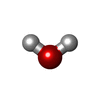+ データを開く
データを開く
- 基本情報
基本情報
| 登録情報 | データベース: PDB / ID: 1lkt | ||||||
|---|---|---|---|---|---|---|---|
| タイトル | CRYSTAL STRUCTURE OF THE HEAD-BINDING DOMAIN OF PHAGE P22 TAILSPIKE PROTEIN | ||||||
 要素 要素 | TAILSPIKE PROTEIN | ||||||
 キーワード キーワード | VIRAL PROTEIN / VIRUS PROTEIN / SALMONELLA PHAGE P22 / TELLUROMETHIONINE / LATE PROTEIN | ||||||
| 機能・相同性 |  機能・相同性情報 機能・相同性情報endo-1,3-alpha-L-rhamnosidase activity / symbiont entry into host cell via disruption of host cell envelope lipopolysaccharide / virus tail, fiber / symbiont entry into host cell via disruption of host cell envelope / symbiont entry into host / 加水分解酵素; 糖加水分解酵素; 配糖体結合加水分解酵素または糖加水分解酵素 / adhesion receptor-mediated virion attachment to host cell / virion attachment to host cell 類似検索 - 分子機能 | ||||||
| 生物種 |  Enterobacteria phage P22 (ファージ) Enterobacteria phage P22 (ファージ) | ||||||
| 手法 |  X線回折 / X線回折 /  多重同系置換 / 解像度: 2.6 Å 多重同系置換 / 解像度: 2.6 Å | ||||||
 データ登録者 データ登録者 | Steinbacher, S. | ||||||
 引用 引用 |  ジャーナル: J.Mol.Biol. / 年: 1997 ジャーナル: J.Mol.Biol. / 年: 1997タイトル: Phage P22 tailspike protein: crystal structure of the head-binding domain at 2.3 A, fully refined structure of the endorhamnosidase at 1.56 A resolution, and the molecular basis of O- ...タイトル: Phage P22 tailspike protein: crystal structure of the head-binding domain at 2.3 A, fully refined structure of the endorhamnosidase at 1.56 A resolution, and the molecular basis of O-antigen recognition and cleavage. 著者: Steinbacher, S. / Miller, S. / Baxa, U. / Budisa, N. / Weintraub, A. / Seckler, R. / Huber, R. | ||||||
| 履歴 |
|
- 構造の表示
構造の表示
| 構造ビューア | 分子:  Molmil Molmil Jmol/JSmol Jmol/JSmol |
|---|
- ダウンロードとリンク
ダウンロードとリンク
- ダウンロード
ダウンロード
| PDBx/mmCIF形式 |  1lkt.cif.gz 1lkt.cif.gz | 171.7 KB | 表示 |  PDBx/mmCIF形式 PDBx/mmCIF形式 |
|---|---|---|---|---|
| PDB形式 |  pdb1lkt.ent.gz pdb1lkt.ent.gz | 139.6 KB | 表示 |  PDB形式 PDB形式 |
| PDBx/mmJSON形式 |  1lkt.json.gz 1lkt.json.gz | ツリー表示 |  PDBx/mmJSON形式 PDBx/mmJSON形式 | |
| その他 |  その他のダウンロード その他のダウンロード |
-検証レポート
| 文書・要旨 |  1lkt_validation.pdf.gz 1lkt_validation.pdf.gz | 401.8 KB | 表示 |  wwPDB検証レポート wwPDB検証レポート |
|---|---|---|---|---|
| 文書・詳細版 |  1lkt_full_validation.pdf.gz 1lkt_full_validation.pdf.gz | 416.5 KB | 表示 | |
| XML形式データ |  1lkt_validation.xml.gz 1lkt_validation.xml.gz | 13.5 KB | 表示 | |
| CIF形式データ |  1lkt_validation.cif.gz 1lkt_validation.cif.gz | 23.9 KB | 表示 | |
| アーカイブディレクトリ |  https://data.pdbj.org/pub/pdb/validation_reports/lk/1lkt https://data.pdbj.org/pub/pdb/validation_reports/lk/1lkt ftp://data.pdbj.org/pub/pdb/validation_reports/lk/1lkt ftp://data.pdbj.org/pub/pdb/validation_reports/lk/1lkt | HTTPS FTP |
-関連構造データ
- リンク
リンク
- 集合体
集合体
| 登録構造単位 | 
| ||||||||||||||||||||||||
|---|---|---|---|---|---|---|---|---|---|---|---|---|---|---|---|---|---|---|---|---|---|---|---|---|---|
| 1 | 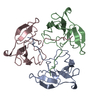
| ||||||||||||||||||||||||
| 2 | 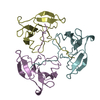
| ||||||||||||||||||||||||
| 単位格子 |
| ||||||||||||||||||||||||
| 非結晶学的対称性 (NCS) | NCS oper:
|
- 要素
要素
| #1: タンパク質 | 分子量: 11307.753 Da / 分子数: 6 / 断片: HEAD-BINDING DOMAIN / 由来タイプ: 組換発現 由来: (組換発現)  Enterobacteria phage P22 (ファージ) Enterobacteria phage P22 (ファージ)属: P22-like viruses / 細胞株: BL21 / 器官: TAIL / プラスミド: BL21 / 生物種 (発現宿主): Escherichia coli / 発現宿主:  #2: 水 | ChemComp-HOH / | |
|---|
-実験情報
-実験
| 実験 | 手法:  X線回折 / 使用した結晶の数: 1 X線回折 / 使用した結晶の数: 1 |
|---|
- 試料調製
試料調製
| 結晶 | マシュー密度: 2.05 Å3/Da / 溶媒含有率: 51.89 % | ||||||||||||||||||||||||
|---|---|---|---|---|---|---|---|---|---|---|---|---|---|---|---|---|---|---|---|---|---|---|---|---|---|
| 結晶化 | pH: 6.6 / 詳細: 20% PEG 8K, 0.2 M MGCL2, 0.1 M BIS-TRIS, PH 6.6 | ||||||||||||||||||||||||
| 結晶化 | *PLUS 手法: 蒸気拡散法 | ||||||||||||||||||||||||
| 溶液の組成 | *PLUS
|
-データ収集
| 回折 | 平均測定温度: 300 K |
|---|---|
| 放射光源 | 由来:  回転陽極 / タイプ: RIGAKU RUH2R / 波長: 1.5418 回転陽極 / タイプ: RIGAKU RUH2R / 波長: 1.5418 |
| 検出器 | タイプ: MARRESEARCH / 検出器: IMAGE PLATE / 日付: 1996年4月1日 |
| 放射 | モノクロメーター: GRAPHITE(002) / 単色(M)・ラウエ(L): M / 散乱光タイプ: x-ray |
| 放射波長 | 波長: 1.5418 Å / 相対比: 1 |
| 反射 | 解像度: 2.6→25 Å / Num. obs: 20822 / % possible obs: 96.5 % / Observed criterion σ(I): 2 / 冗長度: 2.3 % / Rmerge(I) obs: 0.076 |
| 反射 シェル | 解像度: 2.6→2.65 Å / Rmerge(I) obs: 0.298 / % possible all: 72.2 |
| 反射 | *PLUS Num. measured all: 48766 |
| 反射 シェル | *PLUS % possible obs: 72.2 % |
- 解析
解析
| ソフトウェア |
| ||||||||||||||||||||||||||||||||||||||||||||||||||||||||||||
|---|---|---|---|---|---|---|---|---|---|---|---|---|---|---|---|---|---|---|---|---|---|---|---|---|---|---|---|---|---|---|---|---|---|---|---|---|---|---|---|---|---|---|---|---|---|---|---|---|---|---|---|---|---|---|---|---|---|---|---|---|---|
| 精密化 | 構造決定の手法:  多重同系置換 / 解像度: 2.6→8 Å / σ(F): 2 / 多重同系置換 / 解像度: 2.6→8 Å / σ(F): 2 /
| ||||||||||||||||||||||||||||||||||||||||||||||||||||||||||||
| 精密化ステップ | サイクル: LAST / 解像度: 2.6→8 Å
| ||||||||||||||||||||||||||||||||||||||||||||||||||||||||||||
| 拘束条件 |
| ||||||||||||||||||||||||||||||||||||||||||||||||||||||||||||
| ソフトウェア | *PLUS 名称:  X-PLOR / 分類: refinement X-PLOR / 分類: refinement | ||||||||||||||||||||||||||||||||||||||||||||||||||||||||||||
| 精密化 | *PLUS Num. reflection obs: 18825 / Rfactor obs: 0.186 | ||||||||||||||||||||||||||||||||||||||||||||||||||||||||||||
| 溶媒の処理 | *PLUS | ||||||||||||||||||||||||||||||||||||||||||||||||||||||||||||
| 原子変位パラメータ | *PLUS | ||||||||||||||||||||||||||||||||||||||||||||||||||||||||||||
| 拘束条件 | *PLUS
|
 ムービー
ムービー コントローラー
コントローラー




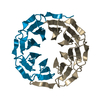
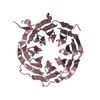
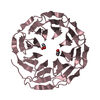
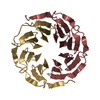


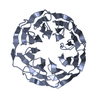
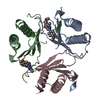
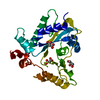
 PDBj
PDBj